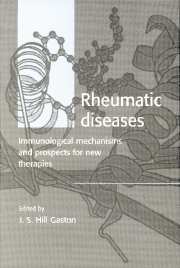Book contents
- Frontmatter
- Contents
- List of contributors
- 1 Implications of advances in immunology for understanding the pathogenesis and treatment of rheumatic disease
- 2 The role of T cells in autoimmune disease
- 3 The role of MHC antigens in autoimmunity
- 4 B cells: formation and structure of autoantibodies
- 5 The role of CD40 in immune responses
- 6 Manipulation of the T cell immune system via CD28 and CTLA-4
- 7 Lymphocyte antigen receptor signal transduction
- 8 The role of adhesion mechanisms in inflammation
- 9 The regulation of apoptosis in the rheumatic disorders
- 10 The role of monokines in arthritis
- 11 T lymphocyte subsets in relation to autoimmune disease
- 12 Complement receptors
- Index
9 - The regulation of apoptosis in the rheumatic disorders
Published online by Cambridge University Press: 06 September 2009
- Frontmatter
- Contents
- List of contributors
- 1 Implications of advances in immunology for understanding the pathogenesis and treatment of rheumatic disease
- 2 The role of T cells in autoimmune disease
- 3 The role of MHC antigens in autoimmunity
- 4 B cells: formation and structure of autoantibodies
- 5 The role of CD40 in immune responses
- 6 Manipulation of the T cell immune system via CD28 and CTLA-4
- 7 Lymphocyte antigen receptor signal transduction
- 8 The role of adhesion mechanisms in inflammation
- 9 The regulation of apoptosis in the rheumatic disorders
- 10 The role of monokines in arthritis
- 11 T lymphocyte subsets in relation to autoimmune disease
- 12 Complement receptors
- Index
Summary
Introduction
Apoptosis is the name used to describe the morphology of cells that die by a variety of insults as well as during normal physiological processes such as embryogenesis and metamorphosis (Kerr, Wyllie & Currie, 1972). The characteristic features of apoptosis include membrane ruffling, cytoplasmic and organelle contraction, nuclear condensation and DNA cleavage. The resulting cellular fragments or apoptotic bodies, are subject to rapid ingestion by neighbouring cells and resident tissue phagocytes. Cell death associated with apoptosis, programmed cell death, has been contrasted with necrotic cell death, which occurs as the result of external damage and is characterized by cell expansion and apparently random disintegration of cellular constituents. More recently, apoptosis and necrosis have been shown not to be two entirely different modes of death but rather the consequence of the nature and strength of the inductive stimulus coupled with the availability of energy sources such as ATP (Leist et al., 1997). A detailed description of apoptosis and its relevance to biomedical science is beyond the scope of this review and the reader is referred to a series of reviews in Science, 10 March, 1995 and 28 August, 1998.
Biochemical regulation of apoptosis
There are two aspects of apoptotic death that are of particular relevance to immune responses.
Apoptotic death is non-inflammatory. Cell fragments are phagocytosed by neighbouring cells and/or professional phagocytes and degraded. Most evidence indicates that phagocytes are not activated following ingestion of these bodies (Savill et al., 1993). The receptors and ligands responsible for uptake of apoptotic cells in mammalian cells are not yet defined.
[…]
- Type
- Chapter
- Information
- Rheumatic DiseasesImmunological Mechanisms and Prospects for New Therapies, pp. 183 - 202Publisher: Cambridge University PressPrint publication year: 1999



